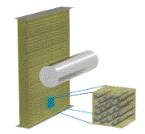Mechanical and Materials Engineering, Department of

Department of Engineering Mechanics: Dissertations, Theses, and Student Research
Date of this Version
5-2016
Document Type
Thesis
Abstract
The promotion of social progress requires greater levels of energy efficiency, quality and productivity. However, these developments usually come at the cost of the environment. Green technologies such as electric vehicles, wind turbine and solar panels are ironically overshadowed by supply limitations and high prices of rare earth elements. Therefore, it is important to find alternative materials to replace those that contain critical elements. Alnico alloys show high magnetization, high Curie temperature (800°C) and good corrosion resistance, making it one of the best candidates to replace neodymium-based magnets used in electric vehicles.
In this thesis, methods controlling shape anisotropy and grain microstructure were used to improve magnetic properties of Alnico. For shape anisotropy, we studied the effects of isothermal heat treatment (IHT), secondary annealing (SA), and alloy composition. The magnetic properties of Alnico were found to be highly sensitive to IHT temperature and time rather than SA temperature and time. Since shape anisotropy is driven by microstructure evolution, it is likely that the evolution has mainly been determined by IHT processing. We found Co increases the spinodal decomposition temperature while it is decreased by Ti. For grain microstructure, we tuned it by controlling wheel speed, and found the optimal magnetic properties were obtained at 20 mps. Textured Alnico was fabricated by setting up a simple casting system. However, a steep temperature gradient was unstable during the casting process due to heat transfer into the atmosphere.
The non-magnetic gamma (γ) phase is known for its deleterious effect on the magnetic properties of Alnico. Here, alloying additions of Sn and Ge were found to decrease amount of γ phase. The role of Sn or Ge could be to suppress γ phase formation or shrink the temperature range over which the γ phase is stable. Furthermore, we studied the effect of magnetic field annealing, and found that its effectiveness depends on IHT temperature and alloy composition. For Alnico 9, the maximum coercivity of 1416 Oe can be obtained after full heat treatment.
Advisor: Jeffrey E. Shield


Comments
A thesis Presented to the Faculty of The Graduate College at the University of Nebraska In Partial Fulfillment of Requirements For the Degree of Master of Science, Major: Mechanical Engineering and Applied Mechanics, Under the Supervision of Professor Jeffrey E. Shield. Lincoln, Nebraska: May, 2016
Copyright (c) 2016 Li Zhang